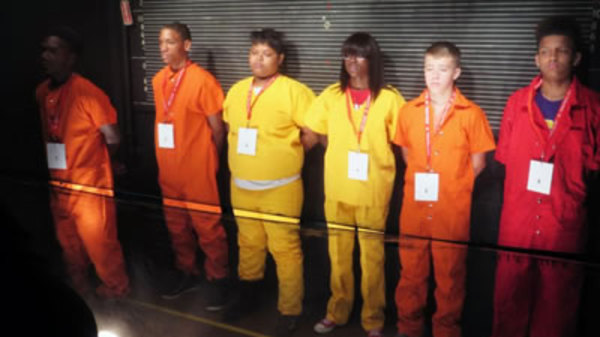The idea of taking troubled youth to a prison or jail to scare them straight is a concept that has been around for decades. This approach, often referred to as “Scared Straight,” gained popularity in the 1970s, and while its effectiveness has been widely debated, it continues to be a subject of interest and controversy. Richland County, SC, like many other areas, has grappled with the question of whether such programs are worthwhile, raising questions about their ethical implications and potential impact on young people.

Image: beyondscaredstraight.fandom.com
In recent years, the “Scared Straight” approach has taken on a new form with programs like “Beyond Scared Straight,” featured in a popular television series. While the premise remains the same—to deter young people from committing crimes by exposing them to the harsh realities of prison life—the methods and outcomes have been subject to further scrutiny. Does “Beyond Scared Straight” really work? And is the potential for harm to these young people worth the potential for rehabilitation?
Understanding the “Scared Straight” Approach and Its Evolution
A History of “Scared Straight”: A Look at Its Roots and Early Programs
The origins of the “Scared Straight” approach date back to the 1970s with the emergence of programs like the “Scared Straight” program in Rahway State Prison, New Jersey. These programs involved bringing groups of at-risk youth to prisons where they would encounter inmates who shared their stories of crime, hardship, and the consequences of their choices. The goal was to shock and frighten young people into avoiding a life of crime.
Early “Scared Straight” programs were often portrayed in documentaries and media features, sparking debates about their effectiveness and ethical considerations. While some individuals claimed to have been positively influenced by these experiences, concerns arose about the potential for psychological harm and the lack of evidence-based support.
“Beyond Scared Straight”: A Modern Take on the “Scared Straight” Concept
The “Beyond Scared Straight” television series, which aired on A&E from 2011 to 2016, brought the “Scared Straight” concept back into public discourse. This program followed a similar format, exposing troubled youth to inmates in prison settings, but it incorporated elements of reality television drama and emotional manipulation.
The show garnered significant attention and controversy. While proponents of the program argued that it offered a powerful deterrent to crime, critics raised concerns about ethical practices, exploitation of vulnerable youth, and the potential for unintended consequences. These debates and critiques fueled discussions about the need for more effective and ethical methods of youth rehabilitation.

Image: simkl.com
Evaluating the Effectiveness of “Scared Straight” and “Beyond Scared Straight” Programs
The effectiveness of “Scared Straight” programs has been the subject of extensive research and debate. While some early studies suggested a positive impact on reducing crime, later research has yielded mixed and often contradictory results.
The Lack of Long-Term Studies: A Gap in Understanding the Impacts
One of the key challenges in evaluating the effectiveness of these programs is the absence of long-term, rigorous studies. Many studies focused on short-term outcomes, and it remains difficult to determine whether any observed changes in behavior were due to the program or other factors.
Ethical Concerns and Potential for Psychological Harm: A Balancing Act
Another major concern is the potential for psychological harm. Exposing young people to violence, aggression, and the harsh realities of prison life can have unintended negative consequences. There is a concern about traumatizing vulnerable individuals, especially those who may already be experiencing emotional distress or behavioral challenges.
Alternative Approaches: Focusing on Positive Reinforcement and Support
The consensus among experts is that more effective approaches to youth rehabilitation focus on positive reinforcement, support, and addressing the underlying causes of crime. Programs that provide counseling, skill-building, and family support are generally considered more promising in achieving long-term positive outcomes for young people.
Beyond Scared Straight in Richland County, SC: Local Concerns and Perspectives
In Richland County, SC, the debate over “Beyond Scared Straight” programs has been particularly relevant. As a community with its own challenges related to youth crime and delinquency, there is a desire to find effective solutions. However, there is also a growing awareness of the limitations and potential downsides of these types of programs.
The Importance of Local Context and Community Involvement: Tailoring Solutions
It is crucial to recognize that every community is unique, and “Beyond Scared Straight” programs may not be the right fit for every context. Richland County residents, community leaders, and organizations need to consider the local needs, resources, and perspectives when addressing the challenges of youth crime and delinquency.
Moving Forward: Focusing on Evidence-Based Interventions and Community Support
The focus in Richland County, SC, and other areas should be on implementing evidence-based programs that have been proven effective in reducing crime and supporting youth development. It is important to invest in community-based initiatives that provide counseling, education, and opportunities for positive change.
Tips and Expert Advice: Supporting Youth and Shaping Responsible Futures
Beyond the debate surrounding “Scared Straight” programs, there are proactive steps individuals and communities can take to support young people and prevent them from engaging in risky or criminal behavior.
1. Foster a Supportive and Engaging Educational Environment
Every student deserves a positive and supportive learning environment. Providing access to quality education, encouraging creative expression, and promoting positive relationships can foster a sense of belonging and purpose, reducing the likelihood of youth engaging in negative behaviors.
2. Empower Youth Through Opportunities for Growth and Skill-Building
Providing opportunities for youth to develop their skills, talents, and interests can make a significant difference. Offering mentorship, internships, and after-school programs can provide constructive outlets for their energy, creativity, and aspirations.
3. Prioritize Open Communication and Building Strong Family Connections
Building strong familial bonds and promoting open communication are essential. By creating a safe and supportive environment where young people feel heard, understood, and valued, families can play a crucial role in shaping positive choices and preventing risky behaviors.
Frequently Asked Questions (FAQs) About “Beyond Scared Straight”
Q: What is the main goal of “Beyond Scared Straight” programs?
A: “Beyond Scared Straight” programs aim to deter young people from committing crimes by exposing them to the harsh realities of prison life through interactions with inmates.
Q: Do “Beyond Scared Straight” programs actually work?
A: The effectiveness of these programs is highly debated. While some studies have shown short-term reductions in crime, other research has shown mixed or inconclusive results. It is difficult to definitively prove their long-term success.
Q: Are there any ethical concerns about “Beyond Scared Straight” programs?
A: Yes. Significant ethical concerns arise, particularly about the potential for psychological harm, manipulation, and exploitation of vulnerable youth. There is a concern that exposing young people to graphic content and intense emotional experiences could have lasting negative consequences.
Q: What are some alternative approaches to youth rehabilitation?
A: Effective alternatives focus on positive reinforcement, support, and addressing the underlying causes of crime. Programs that provide counseling, skill-building, family support, and opportunities for positive growth are generally considered more promising in achieving long-term positive outcomes.
Richland County Sc Beyond Scared Straight
Conclusion: Beyond the Debate – A Focus on Prevention and Empowerment
The debate surrounding “Scared Straight” and “Beyond Scared Straight” programs continues, highlighting the complexities of youth rehabilitation and the need for nuanced and balanced approaches. While these programs have sparked important conversations about crime prevention, the evidence suggests that focusing on positive reinforcement, addressing underlying causes of crime, and investing in community-based initiatives that empower young people with opportunities for positive growth and development is the most promising path for creating safer and more vibrant communities.
Are you interested in learning more about alternative approaches to youth rehabilitation in Richland County, SC? We encourage you to share your thoughts, experiences, and ideas in the comments section below.





